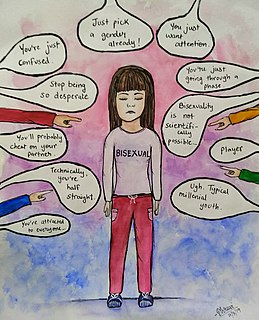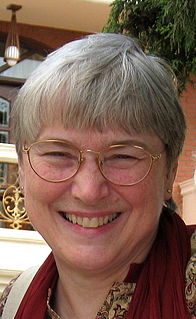Related Research Articles

Biphobia is aversion toward bisexuality and bisexual people as individuals. It is a form of homophobia against those in the bisexual community. It can take the form of denial that bisexuality is a genuine sexual orientation, or of negative stereotypes about people who are bisexual. Other forms of biphobia include bisexual erasure.
Heterosexism is a system of attitudes, bias, and discrimination in favor of female–male sexuality and relationships. It can include the presumption that other people are heterosexual or that female–male attractions and relationships are the only norm and therefore superior.

The field of psychology has extensively studied homosexuality as a human sexual orientation. The American Psychiatric Association listed homosexuality in the Diagnostic and Statistical Manual of Mental Disorders (DSM) in 1952, but that classification came under scrutiny in research funded by the National Institute of Mental Health. That research and subsequent studies consistently failed to produce any empirical or scientific basis for regarding homosexuality as anything other than a natural and normal sexual orientation that is a healthy and positive expression of human sexuality. As a result of this scientific research, the American Psychiatric Association declassified homosexuality as a mental disorder in 1973. Upon a thorough review of the scientific data, the American Psychological Association followed in 1975 and also called on all mental health professionals to take the lead in "removing the stigma of mental illness that has long been associated" with homosexuality. In 1993, the National Association of Social Workers adopted the same position as the American Psychiatric Association and the American Psychological Association, in recognition of scientific evidence. The World Health Organization, which listed homosexuality in the ICD-9 in 1977, removed homosexuality from the ICD-10 which was endorsed by the 43rd World Health Assembly on 17 May 1990.

Societal attitudes toward homosexuality vary greatly across different cultures and historical periods, as do attitudes toward sexual desire, activity and relationships in general. All cultures have their own values regarding appropriate and inappropriate sexuality; some sanction same-sex love and sexuality, while others may disapprove of such activities in part. As with heterosexual behaviour, different sets of prescriptions and proscriptions may be given to individuals according to their gender, age, social status or social class.

LGBT rights opposition is the opposition to legal rights, proposed or enacted, for lesbian, gay, bisexual, and transgender people.

Lesbian, gay, bisexual, and transgender (LGBT) persons in Romania may face legal challenges and discrimination not experienced by non-LGBT residents. Attitudes in Romania are generally conservative, with regard to the rights of gay, lesbian, bisexual, and transgender citizens. Nevertheless, the country has made significant changes in LGBT rights legislation since 2000. In the past two decades, it fully decriminalised homosexuality, introduced and enforced wide-ranging anti-discrimination laws, equalised the age of consent and introduced laws against homophobic hate crimes. Furthermore, LGBT communities have become more visible in recent years, as a result of events such as Bucharest's annual pride parade and Cluj-Napoca's Gay Film Nights festival. In 2006, Romania was named by Human Rights Watch as one of five countries in the world that had made "exemplary progress in combating rights abuses based on sexual orientation or gender identity." In 2021, ILGA-Europe ranked Romania 25 out of 27 EU countries for LGBT rights protection, behind all EU countries except Latvia and Poland.

Stereotypes about lesbian, gay, bisexual and transgender (LGBT) people are based on their sexual orientations, gender identities, or gender expressions. Stereotypical perceptions may be acquired through interactions with parents, teachers, peers and mass media, or, more generally, through a lack of firsthand familiarity, resulting in an increased reliance on generalizations.
Homophobia encompasses a range of negative attitudes and feelings toward homosexuality or people who are identified or perceived as being lesbian, gay, bisexual or transgender (LGBT). It has been defined as contempt, prejudice, aversion, hatred or antipathy, may be based on irrational fear, and is also related to religious beliefs.

Homosexuality is romantic attraction, sexual attraction, or sexual behavior between members of the same sex or gender. As a sexual orientation, homosexuality is "an enduring pattern of emotional, romantic, and/or sexual attractions" to people of the same sex. It "also refers to a person's sense of identity based on those attractions, related behaviors, and membership in a community of others who share those attractions."
The Cass identity model is one of the fundamental theories of LGBT identity development, developed in 1979 by Vivienne Cass. This model was one of the first to treat LGBT people as normal in a heterosexist society and in a climate of homophobia and biphobia instead of treating homosexuality and bisexuality themselves as a problem. Cass described a process of six stages of LGBT identity development. While these stages are sequential, some people might revisit stages at different points in their lives.

The questioning of one's sexual orientation, sexual identity, gender, or all three is a process of exploration by people who may be unsure, still exploring, or concerned about applying a social label to themselves for various reasons. The letter "Q" is sometimes added to the end of the acronym LGBT ; the "Q" can refer to either queer or questioning.
Gay affirmative psychotherapy is a form of psychotherapy for non-heterosexual people, specifically gay and lesbian clients, which focuses on client comfort in working towards authenticity and self-acceptance regarding sexual orientation, and does not attempt to "change" them to heterosexual, or to "eliminate or diminish" same-sex "desires and behaviors". The American Psychological Association (APA) offers guidelines and materials for gay affirmative psychotherapy. Affirmative psychotherapy affirms that homosexuality or bisexuality is not a mental disorder, in accordance with global scientific consensus. In fact, embracing and affirming gay identity can be a key component to recovery from other mental illnesses or substance abuse. Clients whose religious beliefs are interpreted as teaching against homosexual behavior may require some other method of integration of their possibly conflicting religious and sexual selves.

Bisexuality is romantic attraction, sexual attraction, or sexual behavior toward both males and females, or to more than one gender. It may also be defined to include romantic or sexual attraction to people regardless of their sex or gender identity, which is also known as pansexuality.

Dorothy Riddle is an American-Canadian psychologist, feminist and economic development specialist. She is known as the author of the Riddle homophobia scale and published work on women's studies, homophobia, services and metaphysics.

Sexual stigma is a form of social stigma against people who are perceived to be non-heterosexual because of their beliefs, identities or behaviors. Privileged individuals, or the majority group members, are the main contributors of placing sexual stigmas on individuals and their minority group. It is those who hold a higher status that determine within a society which groups are deemed unworthy of a higher status by labeling their specific actions or beliefs. Stereotypes are then produced which further the debilitating effects of the label(s) placed on group members with non-heterosexual beliefs or practices.

Historically speaking, lesbian, gay, bisexual, and transgender (LGBT) people have not been given equal treatment and rights by both governmental actions and society's general opinion. Much of the intolerance for LGBT individuals come from lack of education around the LGBT community, and contributes to the stigma that results in same-sex marriage being legal in few countries (31) and persistence of discrimination, such as in the workplace.

Discrimination against gay men, sometimes called gayphobia, is a form of homophobic prejudice, hatred, or bias specifically directed toward gay men, male homosexuality, or men who are perceived to be gay. This discrimination is closely related to femmephobia, which is the dislike of, or hostility toward, individuals who present as feminine, including gay and effeminate men. Discrimination against gay men can result from prejudicial reactions to one's feminine mannerisms, styles of clothing, and even vocal register. Within the LGBT-community, internalized issues around meeting social expectations of masculinity have been found among gay, bisexual, and transgender men.

The following outline offers an overview and guide to LGBT topics.
Homophobia in ethnic minority communities is any negative prejudice or form of discrimination in ethnic minority communities worldwide towards people who identify as–or are perceived as being–lesbian, gay, bisexual or transgender (LGBT), known as homophobia. This may be expressed as antipathy, contempt, prejudice, aversion, hatred, irrational fear, and is sometimes related to religious beliefs. While religion can have a positive function in many LGB Black and Minority Ethnic (BME) communities, it can also play a role in supporting homophobia.
References
- ↑ Staten Island LGBT history Staten Island LGBT Community Center, Accessed Dec. 19, 2010.
- ↑ Riddle, D. I. (1985). Homophobia scale. Opening doors to understanding and acceptance: A facilitator’s guide for presenting workshops on lesbian and gay issues, Workshop organized by Kathy Obear and Amy Reynolds, Boston. Unpublished essay.
- ↑ Riddle, D., (1994). The Riddle scale. Alone no more: Developing a school support system for gay, lesbian and bisexual youth. St Paul: Minnesota State Department.
- ↑ Peterkin, A. Risdon, C., (2003). Caring for lesbian and gay people: A clinical guide. Toronto: University of Toronto Press, Inc.
- ↑ Clauss-Ehlers, C. S. (ed), (2010). Encyclopedia of Cross-Cultural School Psychology. New York: Springer.
- ↑ Blumenfeld W. J. (2000). How homophobia hurts everyone. Readings for diversity and social justice. New York: Routledge, 267–275.
- ↑ Ollis, D., (2004). I’m just a home economics teacher. Does discipline background impact on teachers’ ability to affirm and include gender and sexual diversity in secondary school health education programs? AARE Conference, Melbourne 2004
- ↑ Hirscheld, S., (2001). Moving beyond the safety zone: A staff development approach to anti-heterosexist education. Fordham Urban Law Journal, 29, 611–641.
- ↑ Finkel, M. J., Storaasli, R. D., Bandele, A., and Schaefer, V., (2003). Diversity training in graduate school: An exploratory evaluation of the safe zone project. Professional Psychology: Research and Practice, 34, 555–561.
- ↑ Tucker, E. W, and Potocky-Tripodi, M., (2006). Changing heterosexuals' attitudes toward homosexuals: A systematic review of the empirical literature. Research on Social Work Practice, 16 (2), 176–190.